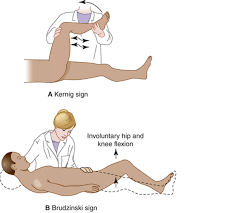Brudzinski – Kernig test
The Brudzinski and Kernig tests are two clinical maneuvers used to assess for signs of meningitis, a serious infection, or inflammation of the membranes surrounding the brain and spinal cord. These tests are typically performed during a physical examination and help evaluate the presence of meningeal irritation.
Table of Contents
Introduction
One of the visible signs of meningitis is Brudzinski’s sign. When a patient’s neck is flexed, his or her hips and knees flex as well.
Purpose
Meningitis is diagnosed using Brudzinski’s sign.
Technique
To perform Brudzinski’s sign
Step 1: The position of the Patient is a supine position.
Step 2: From behind, gently grip the patient’s head and place the other hand on the patient’s chest.
Step 3: Gently flex your neck, bringing your chin to your chest.
Step 4: automatic flexion of the hips and knees (an automatic reflex to minimize the stretch on the inflamed meninges) is a favorable indicator.
Clinical Significance
- Meningitis is an acute illness that, if not treated quickly, can result in lasting neurologic consequences or even death.
- Clinical indications and symptoms that aid in early identification and therapy start are critical for reducing long-term consequences. While Brudzinski’s sign does not definitively rule out meningitis, it might raise clinical concern and prompt early treatment.
- If Brudzinski’s sign is present, there is a strong risk of meningitis due to its great specificity for the condition. A positive test can help providers who suspect meningitis by allowing them to start medication sooner.
- However, due to the sign’s low sensitivity, the lack of the sign does not rule out meningitis.
Evidence
The research included 297 people with suspected meningitis, and the goal was to investigate the diagnostic accuracy of Kernig’s sign, Brudzinski’s sign, and Nuchal stiffness for meningitis. According to the research, Kernig’s sign has a diagnostic value of
- 5% Sensitivity
- 95% specificity
- 27% positive predictive value
- 72% negative predictive value
- According to the findings of this investigation, the diagnostic accuracy of Kernig’s sign and Brudzinski’s sign for patients with moderate to severe meningeal inflammation and microbiological evidence of CSF infection was low. In addition, individuals with severe meningitis have a low diagnostic value for both Kernig’s sign and Brudzinski’s sign based on test results.
- According to another study, Kernig’s and Brudzinski’s signs had poor sensitivity and high specificity for detecting meningitis.
- When both signs disappear, the poor sensitivity suggests that there is no evidence of meningitis.
When both signs are present, there is a strong risk of meningitis, according to the high specificity.
Both Kernig’s and Brudzinski’s signs are extensively used in clinical practice.
Kernig’s sign
The test is named after Russian neurologist Woldemar Kernig (1840-1917).
Introduction
- The Kernig sign is one of the clinical indications of meningitis. This test frequently takes place on supine individuals and is described as resistance (or discomfort) with passive knee extension. This resistance is hypothesized to be caused by meningeal inflammation during meningitis or other clinical entities that irritate the meninges.
- The therapeutic use of the Kernig sign has been extensively researched since its origin in the eighteenth century. It is still a popular procedure used in situations of suspected meningitis.
Purpose
Meningitis is diagnosed using Kernig’s sign.
Technique
To perform Kernig’s sign
Step 1: Position the patient supine with hip and knee flexed to 90 degrees.
Step 2: The examiner slowly extends the knee (repeat on both legs).
Step 3: A positive Kernig’s sign is demonstrated by resistance or discomfort, as well as the inability to extend the patient’s knee beyond 135 degrees due to pain.
Evidence
The research was done on 297 people with suspected meningitis, and the aim was to diagnostic the accuracy of Brudzinski’s sign, Kernig’s sign, and Nuchal stiffness for meningitis. Furthermore, the study found that Kernig’s sign had a diagnostic value of
- 5% Sensitivity
- 95% specificity
- 27% positive predictive value
- 72% negative predictive value
- The findings of this study reveal that Kernig’s and Brudzinski’s signs have poor diagnostic accuracy in patients with moderate to severe meningeal inflammation and microbiological evidence of CSF infection.
- In addition, individuals with severe meningitis have a low diagnostic value for both Kernig’s sign and Brudzinski’s sign based on test results.
- According to another study, Kernig’s and Brudzinski’s signs had poor sensitivity and high specificity to identify meningitis.
- When both indications are missing, low sensitivity suggests that there is no evidence of meningitis.
When both indications are present, there is a strong risk of meningitis, according to the high specificity.
Both Kernig’s and brudzinski’s signs are extensively used in clinical practice.
FAQ
Bedside diagnostic symptoms for suspected instances of meningitis include Kernig’s sign, Brudzinski’s sign, and nuchal stiffness. Meningeal irritation, on the other hand, is not pathognomonic for meningitis.
Brudzinski’s sign is one of the physically visible indicators of meningitis. When a patient’s neck is flexed, his or her hips and knees flex as well.
The Kernig sign is a bedside physical exam maneuver that has been used to assist identify meningitis since its discovery in the nineteenth century. In the presence of meningeal irritation, a positive test is the elicitation of discomfort or resistance with passive extension of the patient’s knees past 135 degrees.
Kernig’s sign is induced by meningeal irritation generated by spinal cord or nerve movement against the meninges. Stretching the hamstring while executing Kernig’s sign pushes on the surrounding tissue around the irritated spinal canal and meninges.
Kernig’s procedure works by having the supine patient passively stretch the leg with hips and knees flexed. If the leg extension causes discomfort, the test is affirmative. When passive forward flexion of the neck leads the patient to automatically elevate his knees or hips in flexion, Brudzinski’s sign is positive.
Kernig’s sign is one of the physically visible indicators of meningitis. When the hip is extended to 90 degrees, severe hamstring tightness prevents the leg from straightening.
Brudzinski’s signature: a) Upper: When examining neck stiffness, moving the chin towards the chest promotes reflex bending of the lower limbs at the hip and knee joints. b) Lower: The same lower limb flexion is induced when pressure is applied to the pubic symphysis.
Brudzinski reported in 1909 that Kernig’s sign was 57% sensitive for patients with bacterial or tuberculous meningitis, while Brudzinski’s nape-of-the-neck sign was 96% sensitive [5]. These clinical findings have now been regarded as indications of meningeal inflammation.
Meningeal symptoms (stiff neck, Kernig’s or Brudzinski’s signs) are not consistently present in infants aged 6 months. It may also identify chronic vomiting, behavioral abnormalities, or other psychological/neurologic indications.





![Test for tight retinacular [ collateral ] ligaments](https://samarpanphysioclinic.com/wp-content/uploads/2023/06/Test-for-tight-retinacular-_-collateral-_-ligaments.webp)
